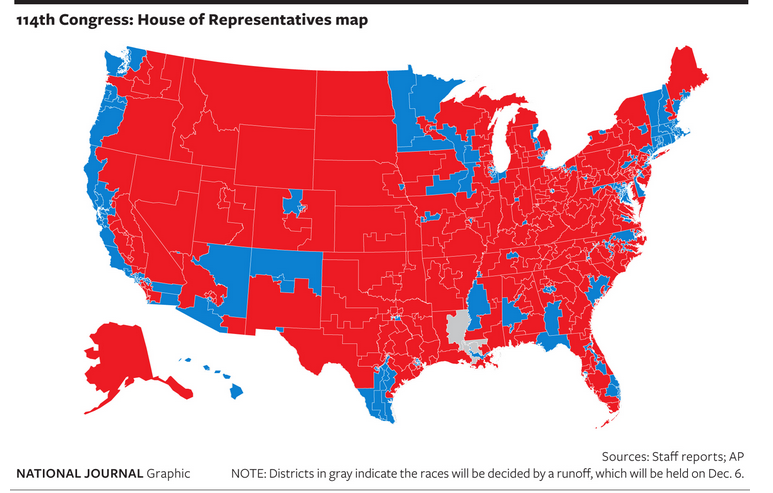Michael Barone posted an article at National Review today analyzing the various voting groups that make up the American electorate and the changes they are going through.
This is the House of Representatives map from the National Journal:
 In his article at the National Review, Michael Barone describes this map:
In his article at the National Review, Michael Barone describes this map:
It looks almost entirely red, except for some pinpoints of blue in major metropolitan areas and a few blue blotches here and there — in Minnesota, northern New Mexico and Arizona, western New England, along the Pacific Coast.
Mr. Barone points out that the map is actually misleading–the population density in the blue areas is generally much greater than in the red areas.
The article at National Review explains:
But it (the map) does tell us something about the geographic and cultural isolation of the core groups of the Democratic party: gentry liberals and blacks.
These were the two groups gathered together when Barack Obama had the opportunity to draw the new lines of his state senate district after the 2000 census. He combined the heavily black South Side of Chicago with Gold Coast gentry liberals north of the Loop.
Together, they provided him with an overwhelmingly Democratic voter base and with access to the upper financial and intellectual reaches of the Democratic party — and, in short time, the presidency of the United States.
The article at National Review explains that the number of black voters in 2014 was only slightly down from 2012–from 13 percent of voters to 12 percent of voters (that is not unusual in a mid-term election). However, blacks are not a growing segment of the voting population, and Democrats will probably never again win the 91 percent of the black vote they won in 2008.
The percentage of Hispanic voters is rising, but they are not guaranteed Democrat voters–some of the key issues of the Democrats have alienated the Hispanic vote–abortion, gun control, and opposition to fracking. So the Democrats cannot automatically count on those votes in the future (this might explain the Democrats focus on legalizing illegal aliens).
The article at National Review concludes:
Analysts who separate Americans into two tidy categories — white and non-white — assume that the non-white category will grow and that whites can’t vote any more Republican than they have historically. Presto, a Democratic America.
The first assumption is well founded. But Hispanics and Asians are not replicating blacks’ voting behavior, just as they haven’t shared their unique historic heritage. In some states, they’re voting more like whites than like blacks.
The second assumption may not be true at all. History shows that self-conscious minorities tend to vote cohesively, as blacks have for 150 years and southern whites did for 90. It’s an understandable response to feeling outnumbered and faced with an unappealing agenda.
In that case, Romney’s 59 percent or House Republicans’ 60 percent among whites may turn out to be more a floor than a ceiling. And that map may become increasingly familiar.
2016 will be an interesting year–the Presidential campaign has already begun. Who should we watch? On the Democrat side, keep your eye on Elizabeth Warren. On the Republican side, keep your eye on the governors–Scott Walker, Bobby Jindal, John Thune, and the Senators, Rand Paul, Ted Cruz, Rob Portman.
